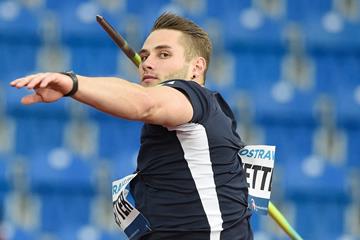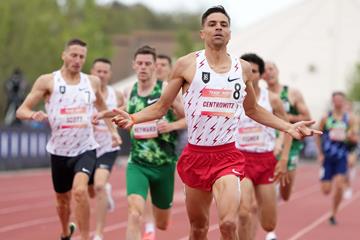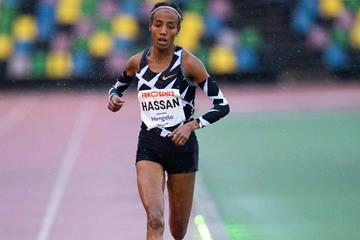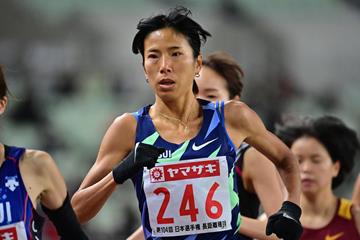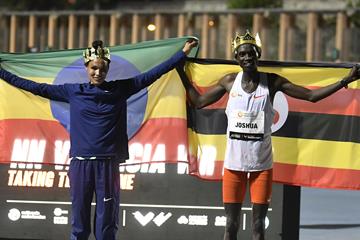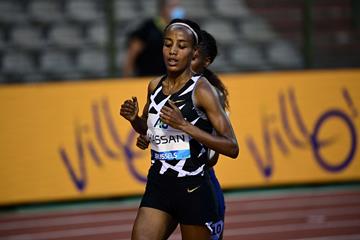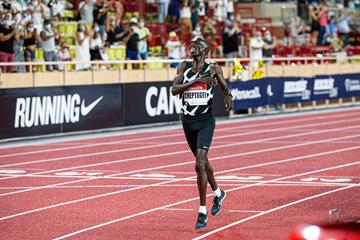 Countdown
Countdown
 Countdown
Countdown
The 10,000m is a long-distance running event that takes place on a standard 400m running track. Athletes complete 25 circuits of the track and the winner is the runner who crosses the finish line in the fastest time.
10,000m is different from a 10km race, which is a road running event
The 10,000m requires runners to have speed, endurance and high levels of aerobic capacity
The 10,000m is typically the longest track event at major championships, including the World Athletics Championships. It is typically run as a straight final
The history of the 10,000m can be traced back to Ancient Greece
During the 19th century, races for betting purposes were very popular in Great Britain and the USA
The men’s 10,000m has been an Olympic event since 1912, while the women’s event was introduced in 1988
Seven athletes have held two Olympic 10,000m titles: six men and one woman
Ethiopia has proved the most successful Olympic country in the women’s 10,000m, with Tirunesh Dibaba winning gold medals for her nation in 2008 and 2012
While the 10,000m is about a quarter of the overall distance of a marathon, it’s still categorised as a long-distance event and is a real test of skill and endurance.
The first pre-recognition women’s 10,000m world record-holder was German runner Gertrud Schmidt, who ran 39:25.0 in 1966. The last pre-recognition world record was set by Soviet runner Olga Bondarenko, with a time of 32:30.8 in 1981.
The first recognised women’s 10,000m world record-holder was Soviet runner Yelena Sipatova, who ran 32:17.20 in October 1981. Sipatova held the record for almost a year until US athlete Mary Decker-Slaney shaved more than 40 seconds off her time, completing the race in 31:35.3.
Between September 1993 and August 2016, Chinese runner Wang Junxia held the world record after clocking 29:31.78. Following this, Ethiopian runner Almaz Ayana then held the record for almost five years, with a time of 29:17.45.
The current women’s 10,000m world record-holder is Kenyan athlete Beatrice Chebet, who ran 28:54.14 in May 2024.
The first six men’s 10,000m world records were all pre-recognition times that were set by British athletes between May 1847 and November 1904. The first record was held by William Howitt, with 32:35.0.
The first recognised world record was set by French runner Jean Bouin in November 1911, with 30:58.8. Bouin held the record for almost 10 years, until June 1921. Following this, five different Finnish athletes broke the record over the course of the next 25 years. When Finnish runner broke the record in September 1939, he became the first athlete to run the 10,000m in less than 30 minutes.
The current men’s 10,000m world record is held by Uganda's Joshua Cheptegei, with 26:11.00. Cheptegei has held the record since October 2020.

Since 1993, the men’s 10,000m world record has only been held by runners from the African continent. This includes Yobes Ondieki, who was the first athlete to run the distance in less than 27 minutes, as well as previous world record-holder Kenenisa Bekele and current world record-holder Joshua Cheptegei.
Ethiopian runner Selemon Barega is the current Olympic champion, while Britain’s Mo Farah won gold in the men’s 10,000m at both the London 2012 and Rio 2016 Olympics.
To date, six men have claimed at least two Olympic 10,000m titles: Paavo Nurmi (Finland), Emil Zatopek (Czech), Lasse Viren (Finland), Haile Gebrselassie (Ethiopia), Kenenisa Bekele (Ethiopia) and Mo Farah (Great Britain).
Notable women’s 10,000m runners include three-time Olympic medallist (including two-time champion) Tirunesh Dibaba, two-time medallist Vivian Cheruiyot and current Olympic champion Sifan Hassan.
Because the 10,000m is a long-distance track event, it requires careful pacing to avoid burnout and ensure the fastest time possible.
Pacemakers aren’t used in championship 10,000m races.
Most runners will employ a steady pace to conserve energy for the final few laps
Runners will often stay with the pack to set the expected pace and help reduce wind resistance
Lap splits may be used to maintain pace or make adjustments
Runners may temporarily increase their speed to break away from the pack and test the endurance of fellow competitors
Runners will kick during the final lap or two, which is a final burst of speed, and use their remaining energy in an attempt to cross the finishing line first
There are several phases throughout a 10,000m race:
Athletes are bunched and begin the race in a standing position, ensuring their hands are not touching the ground.
‘On your marks,’ is announced, followed by the firing of the pistol. This signals the start of the race.
Athletes will quickly bunch together along the inside of the track. This is because this is the shortest route, and athletes are not required to stay in assigned lanes. The pack establishes the pace, with athletes in the centre of the pack at risk of being boxed in.
Runners keep a steady pace to maintain energy and avoid burnout. Athletes may occasionally have a short burst of speed in an effort to break away from the pack and encourage competitors to run at a pace that risks burnout.
As the end of the race approaches, runners will gradually increase their pace. Athletes are more likely to have longer bursts of speed in an attempt to break further from other competitors.
The kick begins, which is a final, prolonged sprint in the closing stages. At this stage, runners will look to use their remaining energy in an effort to be the first to cross the finish line.
The rules of a 10,000m race separate the event from other long-distance events, including the 10km. The 10,000m is a track event, with 25 laps of a 400m track.
Athletes may only begin the race following the firing of the pistol. Because starting blocks aren’t used in a 10,000m race, false starts are identified through visual observation.
10,000m athletes are disqualified if they cause a false start.
As well as disqualification for a false start, athletes in the 10,000m may also be disqualified for unsportsmanlike conduct, breaking the rules or impeding other athletes.
The race winner is the athlete whose torso crosses the finish line first. This is regardless of whether an athlete’s hands, legs, arms or head cross the line first.
Because the 10,000m is a long-distance race, weather conditions don’t play a part. There are no specific wind requirements for 10,000m races.
A 10,000m race is run by completing 25 continuous laps of a standard 400m track.
Properly pacing a 10,000m race is vital. Before the race begins, you should set an overall time you would like to achieve. This time can then be divided by the number of laps (25). This will provide you with an average lap time to aim for.
When training, attempt to do some sessions at a race pace. You should aim to maintain consistency during earlier laps and conserve energy for the kick during the final lap.
Running a 10,000m race can be a huge mental and physical challenge. Try to stay focused on your own pace and don’t worry about other competitors – they may temporarily increase their speed in an effort to make other runners step out of their comfort zone and burn out sooner.
The lead-up to a 10,000m race involves physical and mental preparation, as well as ensuring you have the right nutrition and rest.
Training should begin at least eight weeks before a race. However, if you haven’t run a 10,000m race before, then you should allow more time. During training, gradually increase the distance you run until you’re confident you can run 25 laps of a 400m track in one go.
During training, you should also vary the tempo of your runs to help build endurance. Always warm up and cool down to avoid injury and speed up the body’s recovery.
Added to this, you should eat a protein-rich, nutritionally balanced diet (for example, grilled chicken and vegetables) and drink plenty of fluids. You should avoid high-fibre or fatty foods before running a race.
It’s not recommended that you use sprint spikes when running in a 10,000m race. This is because:
Sprint spikes are designed for an initial burst of speed, with the spikes placed towards the toes in order to keep runners on the balls of their feet
Shoes with sprint spikes don’t have much cushioning and can be uncomfortable over long distances
There’s an increased risk of accident or injury over long distances
There’s a risk of pain or discomfort, which may impact your overall performance
Running events can usually be separated into three categories: short-, middle-, and long-distance.
Long-distance running events are races that are more than 3000m (1.86 miles). This includes the 5000m, 10,000m, half marathon and the marathon.
Paris 2024 Olympic Games
World Athletics Championships Tokyo 25
 ETH
ETH
 ETH
ETH
 ETH
ETH
 KEN
KEN
 FRA
FRA
 RSA
RSA
 UGA
UGA
 USA
USA
 UGA
UGA
 SWE
SWE
 KEN
KEN
 ITA
ITA
 KEN
KEN
 ETH
ETH
 JPN
JPN
 ETH
ETH
 UGA
UGA
 ETH
ETH
 ETH
ETH
 GBR
GBR
